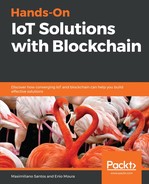In this section, we'll explore the participants involved in a food chain, and look at their activities and the regulations applied to each part of the process. We will look at the following participants in more detail:
- Farmers
- Food manufacturers
- Warehouses and distribution centers
- Transporters (transportation companies)
- Food retailers and supermarkets
- Consumers
- Regulatory agencies
- Certification and compliance
The following diagram shows all the actors in this complex food chain. The main purpose of this chapter is to identify how IoT and blockchain can be used together to increase the confidence in the veracity of information being shared, to reduce human error, and to ensure provenance with immutable data:

From a technological perspective, IoT is the icing on the solution's cake. Nowadays, there are a lot of asset-tracking sensors that can connect and transfer data via bluetooth, ultra-wide band (UWB), Wi-Fi, LPWA, LTE, NB-IoT, 5G, satellite, infrared, ultrasound, NFC, and RFID. This combination of multiple connections allows for asset tracking that provides instant information.
Now that you are able to access data by using IoT, think about storing this information in a blockchain network. Let's revisit the concept of the blockchain. First, we can say that a blockchain provides us with the trust needed for a reliable process, which was not previously present. But now, with blockchain technology, we are able to share many types of information across many ecosystems.
It also provides enough trust to allow us to truly solve the problems that we mentioned previously so that we can serve our customers in a better way. In addition to this, by creating this important trust, blockchain allows us to use the assets that we have already invested in. These are represented by the data that we've built up over decades and new types of analytics: cognitive, machine learning, predictive, big data, and many other similar ones. Moreover, we can say that blockchain represents the missing puzzle piece that brings these all together.
Some important things that our blockchain solutions need to achieve are as follows:
- Providing the transparency that the food industry needs
- Creating trustworthy connections so that everyone in the food ecosystem can participate
- Improving interoperability so that the industry can drive usability and access
- Monitoring livestock and grain monitoring
- Identifying the location of livestocks
- Greenhouse monitoring (temperature and irrigation)
Later in this chapter, we will look at how we can achieve all of this.
